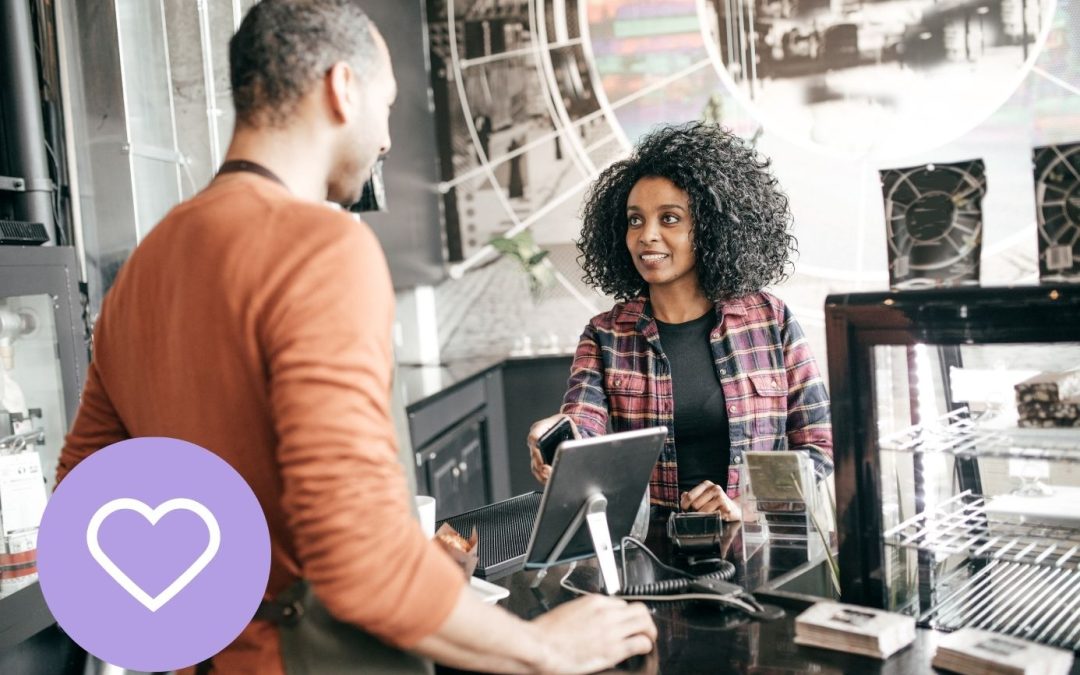
Mar 28, 2023 | Marketing
Advocacy is the final stage of the local customer journey and one of the most important. This is the stage where you focus on building loyal, repeat customers. These individuals have already become paying customers and are pleased with your goods or services. Now is the time to transform these repeat customers into advocates for your company.
Why is Customer Advocacy Important?
Developing customer advocates is not only important, but it’s also critical to future business success.
Repeat Purchases
As a small business owner, you know how important each sale is. You also know how long it can take to convert a potential customer into a purchasing one. Loyal customers don’t typically require the same time commitment. They often make repeat purchases with little to no coaxing. They are the first to attend sales events and participate in special promotions.
Recommend to Other
Customer advocates are also more likely to recommend your store to others, leave positive reviews and engage in social media. These factors are so important. According to a Nielsen study, 80% of Americans seek recommendations from their family, friends, and peers before purchasing. Without loyal customers to provide these recommendations and boost your store’s reputation, you risk losing out on these sales.
Boost Sales
If you’re looking for long-term success, your business cannot afford to overlook the power of customer loyalty. Between their repeat purchases and bringing in new customers, your most loyal customers have the potential to impact the success of your business significantly. One study reveals that your business could receive up to a 200% increase in revenue business growth with just a 12% increase in customer advocacy.
How to Develop Customer Advocates?
Now that you understand customer advocacy’s importance, you can build a strategy to develop customer advocates for your business.
Encouraging Repeat Purchases
Don’t take your most loyal customers for granted. Sure, they may not need as much coaxing to make a purchase, but they still need tending. These customers should be the first to know about upcoming promotions and sales events. You can direct them to these special offers and new products and services when they visit the store. If they’re shopping online, marketing tools, such as automated messages or special promotions at checkout, can help.
You can also encourage your most loyal customers to provide online business reviews on sites such as Google, Facebook, and Yelp. These reviews can serve as a promotion for your business and reach a larger audience.
Offering Customer Loyalty Rewards
Customer loyalty programs are among the best sales tools for building customer advocates. Not only do these programs give you a chance to thank your customers for their loyalty, but they can make your customers feel special and appreciated. There are many types of customer loyalty programs, including points-based, punch card, tier-based, and cashback. It’s recommended to choose a reward program that offers the best business alignment.
Providing Exceptional Customer Service
Your customer advocates are crucial to your business’s ongoing success, and you should treat them as such. Consider offering a special customer service number to your most loyal customers to ensure you handle any issue promptly. You also want to consider noting these customers’ premium status in your CRM platform to ensure they always receive exceptional customer care.
Our EZtransition’s all-in-one marketing platform can help you engage with customers, foster these relationships and convert your most loyal customers into lifelong advocates.
Book a 30-minute call to discuss our fully integrated platform, designed with robust customer features to guide you to follow up with your leads throughout your business’s local customer journey.

Mar 21, 2023 | Marketing
This article is our fifth in a series that seeks to help educate you, a small business owner, in the local customer journey. This journey refers to a five-phase cycle that explains how a customer goes from being aware of your business to making purchases and serving as an ambassador for your brand.
Converting a prospect from considering doing business with you to paying for your products or services is critical. Indeed, it is arguably one of the most critical transitions a customer can make. Fortunately, your business can reduce friction and convert prospects with the right marketing tools.
What Is Conversion?
Conversion is the fourth of the five-phase business cycle. A proper understanding of conversion and how to achieve it will help you develop the business growth you need.
In this instance, conversion refers to turning a prospect into a sale. This means ensuring that the customers follow the appropriate steps to go to your website and pay for a product or service.
How Can You Increase Conversions?
Increasing conversions on your website or for your business isn’t a matter of snapping your fingers. It requires intensive planning and acquiring appropriate sales tools to convert customers appropriately.
Some specific methods you can use include:
- Creating a seamless website design will give your customers the easiest and most frictionless digital experience possible. Customers should be able to find products and services easily. From there, they should be able to do so in a simple manner that still exposes them to additional products or services they may want.
- Retargeting marketing efforts that enable a business to get a user back to their website.
- Appropriately calibrating marketing messages and calls to action that make it clear and easy for your customers to follow through.
- Creating an active social media presence. Your social media content should create evergreen content that can attract the right customer to your website.
What Sales Tools Do You Need to Increase Conversions?
All of the above techniques require data and technology.
On the one hand, you must have the appropriate data. You must know who your customers are and what they are looking for. It would help if you also understood where they spend their time and what messages they respond to best. Since discussing conversions, you must know what website design works best for them. This information will ensure that you optimize your website appropriately.
Furthermore, you need the right technology that makes it easy to obtain this information to apply what you discover. Having data at your fingertips won’t do you any good if you aren’t sure how to act on it. For example, you may know who your ideal customer is. Do you then know what content they are looking for, what website design suits them best, and what information you can collect to maximize your chance of selling to them again?
More often than not, you can boost sales by using the right tools. This information should allow you to track customers through their local business journey and ensure that you are targeting them appropriately. Ready to get started?
Book a 30-minute call today, and learn how our all-in-one marketing platform can increase conversions and ensure you can appropriately achieve business alignment along all five phases of a customer’s sales journey.
Image credits: By Austin Distel on Unsplash

Mar 14, 2023 | Marketing
This article is the fourth in our series dedicated to ensuring your business understands the local customer journey. Reading all articles in this series, you can develop a healthy understanding of the local customer journey, how it impacts the marketing tools you purchase, and how to maximize the customer cycle to achieve business alignment.
Specifically, this article will discuss the reputation stage of the customer journey. This third stage focuses on your online image.
What Is Reputation?
In this context, online reputation refers to what customers think of your business and how they discuss it online.
Imagine the following scenario: A customer who knows your business exists, is looking for your products or services, and finds you online. If they use many search engines, like Google or Yelp, they’ll see reviews of your business. If they see a slew of five-star reviews, they will likely do business with you.
As such, you must understand that reviews are critical to a customer’s sales journey. You must do whatever you can to ensure satisfied customers leave good reviews.
How Can You Increase Your Reputation Among Customers?
Online reviews and reputation are among the best sales tools you can have. When used properly, online reviews can boost sales and convince more customers to do business with you. As such, you should engage in the following behaviors.
Actively Solicit Reviews
Every business should engage in a series of steps to get them more five-star reviews. Examples of specific tactics include reaching out to prospective reviewers before they review a website, having them contact you before making a post, and ensuring that these reviews are easily publicized. If you have satisfied customers, you should ask them to leave positive reviews.
Respond to Reviews – Positive or Negative
By responding to reviews, you can incentivize people to leave good ones while also addressing any concerns brought up by negative ones. Responding to reviews is almost always good: It shows customers you value their opinions and care about their satisfaction.
Monitor for Reviews
Monitoring for reviews is critical. After all, there are many websites — including Google, Yelp, Facebook, and more — where customers can leave reviews. Your challenge will be to track this information, which can be impossible without the right technology.
What Tools Do You Need to Increase Reputation?
Increasing your reputation is all about using the right tools and understanding where your customers spend their time. First, you need to ensure you have the following:
- The right technological tools — so you can track customer sentiment and determine what customers are saying about you
- A formal process in which you respond to reviews and address any concerns mentioned
- Appropriate business incentives for individuals who leave positive reviews
- A process in which you encourage individuals to leave reviews
As you can see, increasing your online reputation is not just about asking nicely. It involves creating multiple business processes and using the right tech tools to track customers’ opinions. At EZtransition, we can help build a formal process that enables you to engage in this process. Book a 30-minute call today and learn how our all-in-one marketing platform can help you respond to customer reviews, seek positive reviews, and achieve business growth.

Mar 7, 2023 | Marketing
This article will be the third in our series dedicated to ensuring your business understands the local customer journey and develops comprehensive knowledge of how that customer journey will impact customer experience. Specifically, this article will discuss the findability stage of the customer journey. This second stage focuses on ensuring customers can find your business when looking for it.
What Is Findability?
Findability is the second of the two stages in a local customer journey. This five-step cycle determines your customer’s awareness of your business and how likely they are to use your products.
In the findability stage, a customer is aware of your business, although not necessarily ready to start giving you their hard-earned money. However, they may be looking for you and doing this both in person and online. If a customer can’t find you when they are looking for your business — or even if they are looking for a local business in your industry — they will ultimately be unable to buy your products. You increase the odds of earning their money by making it easy for a customer to find you. In the long run, doing so will boost sales.
How Can You Increase Customer Findability?
To increase your findability, you must ensure business alignment over various areas of a customer’s sales journey. To achieve this alignment, you need the right marketing tools and sales tools.
Findability usually (but not always) refers to customers finding you online. Perhaps nothing is more important to your findability than increasing your search engine optimization. Increasing your SEO means your website has to be appropriately tagged with the correct keywords and metadata. This allows search engines to find your website.
Local business listings are a critical aspect of the findability stage of the local customer journey for several reasons. Firstly, they provide customers with a comprehensive and up-to-date directory of businesses in their local area, making finding what they are looking for easier. By having a presence on local business listing platforms, businesses can ensure they are visible to potential customers searching for products or services they offer. Secondly, local business listings help improve the accuracy and consistency of a business’s online information, boosting its visibility in search engine results pages. Finally, local business listings also offer customers valuable information such as business hours, contact information, reviews, and ratings, enabling them to decide which businesses to engage with.
However, SEO is about so much more than the right pieces of information. It also refers to ensuring your content is fresh, constantly updated, and geared toward customers looking for you. These days, local search has become much more important for business growth. Individuals are much more likely to find search results based on their area. You must ensure a local audience can find your website with the right content. Local search also makes it easy for customers to find your contact information.
What Do You Need to Increase Findability?
Increasing findability is all about using the right tools and expertise. As such, you need to ensure you have the following:
- Robust knowledge of who buys your products and services. You must know what your ideal customer looks like, what messages they respond to, and what social networks they spend their time on.
- An understanding of optimizing your SEO so these customers can find you.
- Appropriately targeted social media content on the networks where your ideal customer will spend most of their time.
As you can see, increasing findability is about much more than having the right technology. You also have to build the right knowledge base about who your customer is, where you can find them, and where they can find you. So, are you ready to learn how to maximize your business’s findability and learn more about how it impacts your local customer?
Book a 30-minute call today and learn how our all-in-one marketing platform can help increase your findability. In so doing, you can learn more about how customers can move from awareness to findability and become regular customers and brand ambassadors for your business.

Feb 28, 2023 | Marketing
This post is the second in our series dedicated to ensuring that your business fully understands the local customer journey and develops comprehensive knowledge of the five phases of a customer experience. This article will focus on the importance of the awareness stage, the first stage in the local customer journey.
What Is Awareness?
Awareness is the first phase of your local customer journey that will lead to business growth. This journey refers to the experience of all customers as they transition from being completely unaware of your business to becoming its most prominent advocates.
In the awareness phase, a customer knows who you are and what products or services you sell. This awareness means the customer understands the most basic information about your business. This information may include what you do and where you are located. With the right information, customers are more likely to move further along their local customer journey with your business.
How Can You Increase Customer Awareness?
Once upon a time, building awareness was a matter of having a big billboard on your local main street. This broad-based ad, combined with other paid advertising efforts in a local newspaper, used to be enough to give a customer an idea of who you were and what you do.
Of course, those days are long gone. New tools, including targeted advertising, Google ads, and online reviews, are all critical to increasing awareness and will allow you to boost sales. Increasing awareness generally relies on at least two specific marketing tactics, including the following.
Establishing a Strong Online Presence
An online presence means you have a powerful website that uses appropriate SEO strategies and can connect with your customers where they are. It also means you have marketing tools to create a robust social media presence. You create value-added and useful content for the right markets, enhancing your business’s awareness among relevant and appropriately targeted customers.
Using Targeted Marketing
You don’t want to advertise to customers who aren’t likely to do business with you. Instead, you want to market to customers who are most likely to buy your products. As such, you use targeted marketing, potentially taking advantage of extremely targeted SEO opportunities or paid ads on social media platforms. For example, you may purchase Google Ads for individuals searching for your product or service if an individual is in your service area. You’d also look at buying Facebook ads for people who have been to your website.
What Do You Need to Build Awareness?
Every business is on a limited budget. Managing resource constraints means ensuring you get the most “bang for your buck” when engaging in a general awareness campaign. As such, you need to consider the following:
- What sales tools do you invest in, and how do they operate with your other marketing platforms? You must ensure that your tools will easily integrate with your existing operations.
- How are your marketing, sales, and financial planning efforts aligned? Have you achieved business alignment in these areas?
- Do you have a consistent idea of who your customers are, where they spend their time, and what messages they respond best to?
Are you ready to learn how to maximize your business’s customer experience and build more awareness among your customers? Book a 30-minute call today to learn how our fully integrated, all-in-one marketing platform can help increase your business and ensure that more customers know who you are as they start their sales journey with you.
Image credits: By Diego PH on Unsplash.





